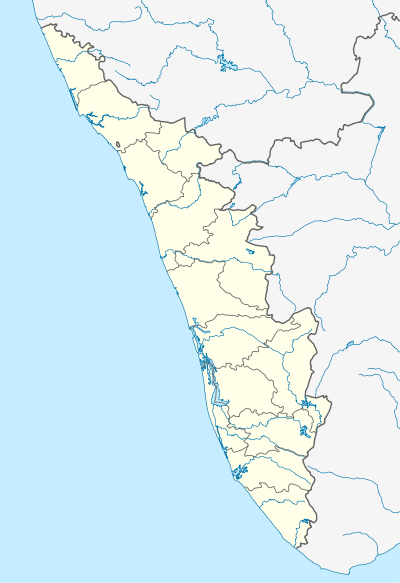Kandiyoor Sree Mahadeva Temple
| Kandiyoor Sree Mahadeva Temple | |
|---|---|
|
| |
 Kandiyoor Sree Mahadeva Temple Location in Kerala | |
| Name | |
| Other names | Dakshina Kashi |
| Proper name | കണ്ടിയൂർ മഹാദേവക്ഷേത്രം |
| Geography | |
| Coordinates | 9°15′11″N 76°31′46″E / 9.25306°N 76.52944°ECoordinates: 9°15′11″N 76°31′46″E / 9.25306°N 76.52944°E |
| Country | India |
| State | Kerala |
| District | Alappuzha |
| Location | Mavelikara |
| Culture | |
| Primary deity | Shiva |
| Architecture | |
| Architectural styles | Traditional Kerala style |
| History and governance | |
| Date established | Before the advent of Kaliyuga |
| Date built | 823[1] |
| Creator | Cheraman Perumal Nayanar Rajasekara Varman |
| Governing body | Travancore Devaswom Board |
| Website | kandiyoortemple.org |
Kandiyoor Sree Mahadeva Temple is an ancient Shiva temple situated in Kandiyoor near Mavelikara on the banks of Achankovil River. Kandiyoor was once the capital of the Odanadu kingdom.[2] It is one among the 108 great Shiva temples of ancient Kerala consecrated by Lord Parashurama himself.[3] The temple is 1 kilometre (0.62 mi) west of Mavelikar town north of State Highway 6. It is spread across an area of 7.5 acres (3.0 ha).
Legends
There are many legends associated with the temple. One such legend concerning the origin of the temple is related to Rishi Mrikandu father of Rishi Markandeya. According to the legend Marikandu got an idol of Lord Shiva in Kirathamoorthy form while bathing in Ganga. He heard an oracle that the idol be place in a holy and befitting place. The Rishi searching for the apt location came to Kerala and ended up in the bank of Achankovil and established the temple in Kandiyoor. The name Kandiyoor is a corruption of Kandathil nalla uru(Best place seen).
According to another legend the temple is located at the site where Lord Shiva cut off Lord Brahma's head. The name Kandiyoor comes from name of Shiva Sri Kantan. It is believed that Lord Parasurama renovated the temple and gave tanthrik rights to Tharananallur family.[4]
History
Kandiyoor and the temple has great significance in Kerals's history. The Kandiyoor temple is the earliest temple about which there is an epigraph about its origin in A.D 823 during the reign of Rajasekhara Varman.[5] There was an era name 'Kandiyoorabdam' from the formation of the temple that was in widespread use until the introduction of Kollavarsham.
It is also believed that the temple was once Hinayana Buddhist temple and King of Mavelikara ordered the removal of Buddha and keep in its place Shivalinga. It is also believed that it is this unseated Buddha that was retrieved from the paddy fields nearby and placed near the Mavelikara temple recently.[6]
The Kandiyoor inscription (K. E. 393) dated 1218 says that Kandiyoor temple was reconstructed by Rama Kotha Varma of Odanad and the Kalasam ceremony was attended by devadicci Unni wife of Ravi Kerala Varma King of Venad after deliberations between the three.[7][8]
Kandiyoor was annexed to Kayamkulam by Kayamkulam Rajah and later to Travancore by Marthanda Varma. It is believed that during the war between Odanadu and Kayamkulam the defeated Kayamkulam Raja surrendered his sword in the temple and left through the rear door which still remains closed after centuries.[4]
The temple is mentioned in Unnuneeli Sandesam written around the 14th century.
Temple Description
The primary deity of the temple is Lord Shiva known as Kandiyoorappan (the ruling deity of Kandiyoor). The deity is east facing. The sanctum santorum is two tiered and there is a platform in the front for devotees, a feature that is of the Hoysala style. The bottom tier is oval in shape while the top tier is rectangular. The 10 feet (3.0 m) Gajaprishta style wall is believed to be constructed by Shiva's Bhothaganas.[4] There are puranic legend stone scriptures in the temple.[9]
Deity
The primary deity, Kandiyoorappan, is believed to be in kirathamoorthy form. The deity worshipped as Dakshinamoorthy in the morning, Umamaheshwaran in the noon, Kirathamoorthy in the evening. Deity is worshipped as Panchmukha from South-West corner of Pradakshina Vazhy by viewing five Thazikakudams of Shiva temples and as Vaikatappan(ruling deity of Vaikom) during sunset. The sub-deities in the temple include Vishnu, Parvatheesan, Nagaraja and Nagayakshi, Gosala Krishnan, Sastha, Sankaran, Sreekandan, Vadakkumnathan, Annapoomeswary, Ganapathy, Subramanyan, Moola Ganapathy and Brahma Rakshas of which Sankara, Sreekanda, Vadakkumnadha, Parvatheesa and Mrityunjayaare Shiva himself. There are six Shivalinga Prathishtas in this temple.[10]
References
- ↑ Shashi, editor-in-chief Padmashri S.S. (2007). Encyclopaedia Indica : India, Pakistan, Bangladesh (1st ed.). New Delhi: Anmol Publications. ISBN 9788170418597.
- ↑ Gouri Lakshmi Bayi (1998). Thulasi garland Bhavan's book university. Bharatiya Vidya Bhavan.
- ↑ 108 Shiva Temples in Kerala created by Lord Parasurama
- 1 2 3 Temple Website
- ↑ A. Sreedhara Menon (1987). Kerala History and its Makers. D C Books. ISBN 9788126437825.
- ↑ Sadasivan, S.N. (2000). A social history of India. New Delhi: APH Pub. Corp. ISBN 9788176481700.
- ↑ University of Kerala (1987). Journal of Kerala Studies, Volume 14. University of Kerala.
- ↑ Singh, Nagendra Kr. (1997). Divine prostitution. New Delhi: A.P.H. Pub. Corp. ISBN 9788170248217.
- ↑ A. Sreedhara Menon (1982). The Legacy of Kerala. D C Books. ISBN 9788126437986.
- ↑ Kandiyoor Mahadeva Temple Mavelikkara
External links
| Wikimedia Commons has media related to Kandiyoor Sree Mahadeva Temple. |
| ||||||||||||||||||||||||||||||||||||||||||||||||||||||||||